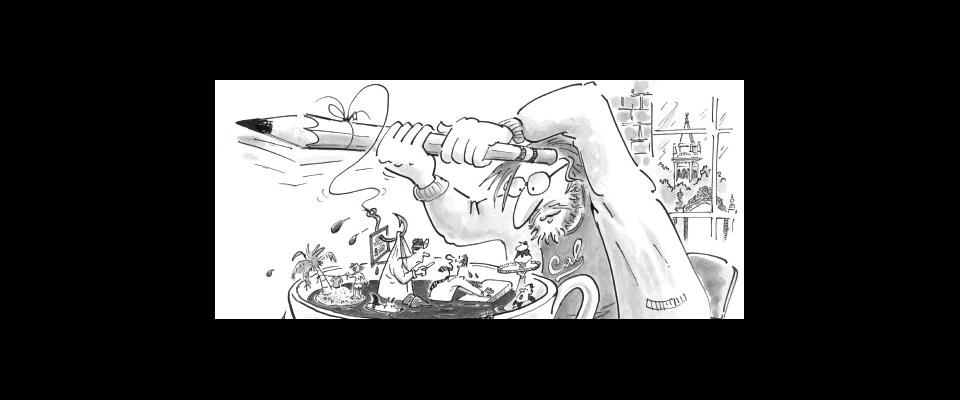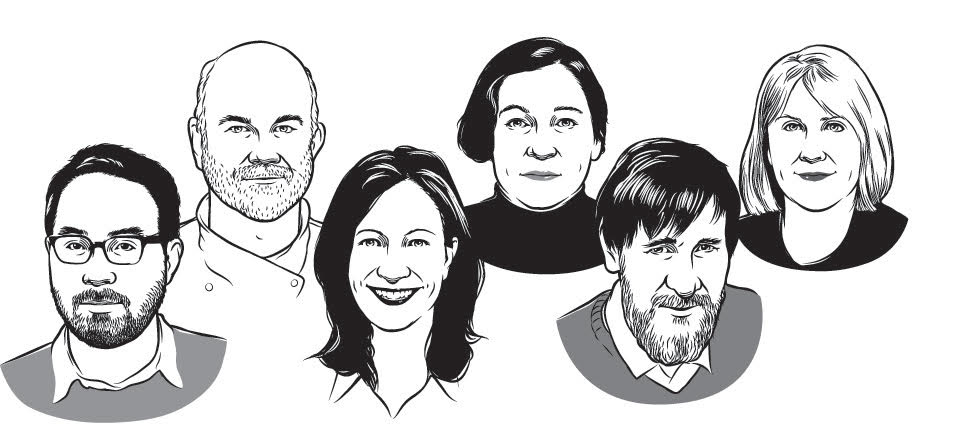Q&A with New Yorker cartoonist Mike Twohy
Bob Mankoff, cartoon editor at The New Yorker, says cartoonists are smarter than scientists. Not funnier, mind you. Smarter. As Mankoff explains, “If a scientist comes up with one new idea a year, he’s a genius. If a cartoonist comes up with only one new idea a day, he’d better start looking for work.” Mike Twohy (pronounced like “2E”), MFA ’73, must be very smart indeed. He has been producing a steady stream of cartoons for that vaunted venue—he calls it “the Met for cartoonists”—for nearly 30 years. And he has done it without moving to Manhattan. His studio is in his home, in the hills above Berkeley. Twohy recently took some time away from his work routine to talk about generating ideas, dealing with rejection, and the artistic uses of cliché.
Pat Joseph: I think what everyone wants to know is: Which comes first, the caption or the drawing?
Mike Twohy: Everyone seems to have a very different approach. I’m a chronic doodler, so I probably start drawing first, although what I try to do is think of something that’s in the news—a phrase or buzzword or whatever—just to get me started. And then things kind of morph from there. For The New Yorker, since it’s a weekly, I look for topical stuff. I spent a week on “lipstick on a pig.” That one didn’t pay off.
PJ: Did you grow up with this ambition to be a cartoonist?
MT: It was one ambition. I remember in high school, I was asked what I wanted to be in an interview and I said I wanted to be—I remember the term—a “satisfied cartoonist.” But when I got to college, I got more interested in fine art and I really wanted to paint. That’s what I intended to do, to paint and to teach painting, when I got my MFA at Berkeley. And then I just kind of got seduced by cartooning a few years later.
PJ: Do you still make forays onto campus?
MT: Yeah, the various coffeeshops around campus are my other office. I go out almost every day to one or another café and I put in about three hours on ideas.
PJ: Do you actually draw there, or are you just jotting stuff down in a notebook?
MT: I use a little laptop tablet that I draw on. I’ve been doing that for about a year. And I love the line and the quickness and the ability to edit things and move things around, so it’s kind of opened things up for me a little bit. You can do halftone. You can do everything. And then you can send them. And more and more magazines are just printing from the computer now, so they don’t need the paper anymore. Which is a little problematic in terms of selling the originals, since there is no original.
PJ: When you’re sitting there with your coffee and your tablet, are you also eavesdropping?
MT: I don’t eavesdrop very much anymore. Maybe I used to be more tuned in, but now I try and block out the conversations and just have it as kind of surrounding energy. But there have been times that I picked up a phrase that has floated above the din and made a saleable cartoon out of it. I also read a couple of newspapers before I go out to do ideas. And I listen to a lot of talk radio, which riles me up.
PJ: So, what’s the relationship like between the editor and the cartoonist? Do you get notes back saying the facial expressions need to be different, or just “Make it funnier”?
MT: Sometimes. Once they said that the top button on a person’s coat should be buttoned. Another time, I had a halibut talking to the receptionist at a business, and the receptionist saying, “One of those fish with the eyes on the same side to see you, sir.” And they didn’t like my halibut. So they sent me a bunch of pictures of halibuts to show me what they really look like.
PJ: The phrasing of the captions seems so important, particularly with The New Yorker.
MT: I play around with the wording and switch things around in my mind all the time. Even after I’ve sent it off, I can’t let go of it.
PJ: I would think it would be difficult to know whether your changes were actually making the work funnier or not. Do you show your revisions to other people?
MT: My wife has been my editor from the very beginning. And we actually met in the art department at UC before I was doing any cartooning. We were both painters back then. She basically sees all the roughs and weeds out the smellers, which I am really not very good at detecting.
PJ: Is it hard getting your cartoons rejected by your wife?
MT: I appreciate it because I really don’t have good perspective. My sense of humor tends to be a little low sometimes.
PJ: Do you think of yourself as funny?
MT: No, no. I was a class clown through school, so there’s something there. But no, I don’t consider myself terribly witty. And a lot of cartoonists I know feel the same way. I knew one guy, Charlie Dennis, who helped me get started cartooning, and he said he was a “stairwell comic,” meaning when he left the party and got to the stairwell, he would be hit by something funny.
PJ: Getting back to the actual work, do you have a steady goal in terms of output?
MT: I send a dozen roughs to The New Yorker weekly and I always feel lucky if they buy one. But there are no guarantees. Like Hollywood, you’re only as good as your last performance.
PJ: It must be hard to get through the dry spells.
MT: It makes me work harder, put in an extra hour on the ideas during the day or whatever. But that’s the game. I’ve been doing it a long time. The advice I give other people is to rejoice in the acceptances and downplay the rejections, because they will get you down.
PJ: Have you been surprised by the success of the caption contest in the back of the magazine?
MT: Yeah, I am surprised that it’s been this popular. Actually, the first one they used was a rat cartoon that I did. They had purchased that cartoon from me already, and Bob [Mankoff, the cartoon editor] called me. He was very apologetic and said that they had a new idea, and would it be OK if they printed mine without the caption and had the readers put one on it? And I said, “Well, certainly. See what happens.”
PJ: So what was the winning caption?
MT: It was—I forget now. But it was actually very close to my caption.
PJ: One more thing that I am intrigued by with cartoons, is all the set pieces. The Grim Reaper being one, the desert island being another, the bar….
MT: Yeah, the psychiatrist’s couch.
PJ: Which is interesting because clichés are generally the death of great art. But with great cartoons, it seems, clichés are often the starting point.
MT: Right. Well, the good thing about the cliché is everybody knows where you’re coming from. Everyone recognizes the cliché to start with, so that gives you something in common with your reader. And then, the goal is to give it a twist so the reader thinks, “I would never have thought of that even though I know the situation so well.”
PJ: Which is no easy trick, I imagine.
MT: Well, it just takes a little perspiration.




















